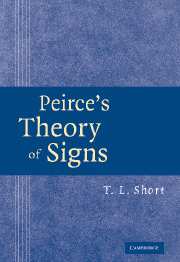Book contents
- Frontmatter
- Contents
- Preface
- Acknowledgments
- 1 Antecedents and Alternatives
- 2 The Development of Peirce's Semeiotic
- 3 Phaneroscopy
- 4 A Preface to Final Causation
- 5 Final Causation
- 6 Significance
- 7 Objects and Interpretants
- 8 A Taxonomy of Signs
- 9 More Taxa
- 10 How Symbols Grow
- 11 Semeiosis and the Mental
- 12 The Structure of Objectivity
- Bibliography
- Name Index
- Subject Index
- Frontmatter
- Contents
- Preface
- Acknowledgments
- 1 Antecedents and Alternatives
- 2 The Development of Peirce's Semeiotic
- 3 Phaneroscopy
- 4 A Preface to Final Causation
- 5 Final Causation
- 6 Significance
- 7 Objects and Interpretants
- 8 A Taxonomy of Signs
- 9 More Taxa
- 10 How Symbols Grow
- 11 Semeiosis and the Mental
- 12 The Structure of Objectivity
- Bibliography
- Name Index
- Subject Index
Summary
Some further aspects of final causation, now to be noted, enable us to define ‘interpret’, ‘sign’, and ‘significance’. Thus begins our systematic reconstruction of Peirce's mature semeiotic. We shall proceed independently of his own words, at first. But in sections 7–9 we will find that our definitions conform to the main features of his later statements, especially those of 1907 and 1909. Those definitions are further verified in the next three chapters, where they provide the framework within which we explicate the divisions of object and interpretant that Peirce made in his last two decades, as well as the taxonomy of signs that he based on those divisions.
Recall that Peirce intended semeiotic to be a science (chapter 1, section 5) and, as such, not an explication of ordinary usage of the word ‘sign’. ‘Sign’ becomes a technical term justified, if at all, by the power of the system of semeiotic to illuminate a wide variety of phenomena. Recall also that this science was intended to provide a naturalistic account of the human mind (chapter 1, sections 3 and 4). Thus its key terms must span the human and the nonhuman. Again, this can be justified only by its success in enabling us to see facts not heretofore noted, in this case, continuities. Synechism is to be established not by fiat but by discovery. I make a particular point of this, lest you cavil at what might seem at first to be gross anthropomorphism.
- Type
- Chapter
- Information
- Peirce's Theory of Signs , pp. 151 - 177Publisher: Cambridge University PressPrint publication year: 2007



